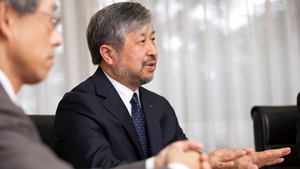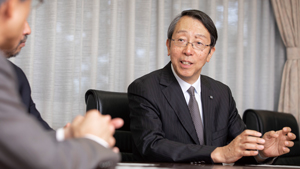About us
JAXA Aviation helps to create a safer and more prosperous society with aeronautics-related research and development activities.
FLIGHT PATH No.21 | 2018 SUMMER
<JAXA's Goals in the Fourth Mid-to-long-term Plan>
Discussion by Three Key Persons Thinking Ahead of the Times and Producing Excellent Researchers to Become the World's Top Research Institution
What kind of social demands should future research by JAXA Aeronautics seek to address?

YOSHIDA: Being a public research institution, JAXA aims to contribute to society through its R&D activities. There are various needs that can't be fulfilled through R&D by companies alone due to the sheer amount of time and costs they entail. That kind of R&D should be led as a nation-wide effort, and to date we have focused our efforts mainly in those areas. As a national research institution, JAXA still has a lot of research themes that it needs to work on. To enhance the level of such technology, I believe JAXA needs well-developed projects. For these projects, we select universal research themes that are not intended to benefit any specific company. In addition to the engine and supersonic aircraft technologies that we are currently working on, there are various requests for research in the areas of manufacturing and production technologies. There is also the issue of aerodynamic noise that we are currently trying to address through the FQUROH project, as well as needs for technology to dramatically reduce aerodynamic drag on an airframe and to cut structural weight. During the seven years of the Fourth Mid-to-long-term Plan, I believe more projects will be launched to conduct research in these areas.
What kind of social demands should future research by JAXA Aeronautics seek to address?
YOSHIDA: Being a public research institution, JAXA aims to contribute to society through its R&D activities. There are various needs that can't be fulfilled through R&D by companies alone due to the sheer amount of time and costs they entail. That kind of R&D should be led as a nation-wide effort, and to date we have focused our efforts mainly in those areas. As a national research institution, JAXA still has a lot of research themes that it needs to work on. To enhance the level of such technology, I believe JAXA needs well-developed projects. For these projects, we select universal research themes that are not intended to benefit any specific company. In addition to the engine and supersonic aircraft technologies that we are currently working on, there are various requests for research in the areas of manufacturing and production technologies. There is also the issue of aerodynamic noise that we are currently trying to address through the FQUROH project, as well as needs for technology to dramatically reduce aerodynamic drag on an airframe and to cut structural weight. During the seven years of the Fourth Mid-to-long-term Plan, I believe more projects will be launched to conduct research in these areas.
MATSUO: I always say that research like that has to be one with ingenuity. Dr. YOSHIDA has just said that that kind of research should be a nation-wide effort. I believe people who have joined JAXA should have aspirations like “I want to become the best in this field” or “I want to create the world's first technology,” and strive to realize those aspirations. That I believe is the desired mindset and approach. We shouldn't try to bring in all the technologies we need from outside and think we can take credit for that. As a rule, we should fully cultivate those technologies. That's what I think is research with ingenuity.
So that's the kind of research JAXA should do.
MATSUO: Yes. That's particularly true for fundamental research.
YOSHIDA: Dr. MATSUO is absolutely right. I don't think research without ingenuity will be able to create technology that a public research institution can hand over to private companies. It's no use trying to imitate what others are doing. I believe it's extremely important to start from basic research and build up from there.
WATANABE: At the Aeronautical Innovation Hub Center, we sometimes do everything from basic research to social implementation. But if there's any technology we're lacking, we work together with colleagues who do fundamental research in our Directorate. While we talk about driving open innovation, after all we are an R&D institution, so our work isn't just about compiling technologies. We should have our own solid foundation of research, and that provides the core enabling significant growth through open innovation. What Dr. Matsuo refers to as research with ingenuity is precisely what makes up the core.
Introducing AI to aeronautical technology
You mentioned AI earlier. Every researcher seems to be paying close attention to it.
WATANABE: Many researchers are interested in its potential. At the Aeronautical Innovation Hub Center, we believe the latest information and communication technology (ICT) like AI, IoT, and big data will serve as common technology in the near future. Therefore, to facilitate activities across our center, we created a new team that specializes in planning, collaboration, and common technology like ICT. With different roles working in isolation, it will be hard to produce synergy effects even though we are a single organization. The R&D of integrated simulation technology undertaken at fundamental research units also uses AI. Since it would be inefficient to have AI teams in many places, I'd like to coordinate these activities across the Directorate as a common effort.
How would AI be useful in an integrated simulation?
MATSUO: As Mr. WATANABE said, the increasing interest in AI, IoT, big data, and so on is a general trend seen in society at large. Aeronautical research, in a sense, is also a collection of big data. There are vast amounts of operational and experimental data, and the amount of simulation data these days can reach enormous levels. Sensors have become extremely sophisticated, and these sensors are being used increasingly to further refine measurement technology or aim for breakthroughs, producing data after data. The R&D of integrated simulation technology is based on an idea of integrating flow analysis, wind tunnel testing, and flight testing to boost added-value. But that's something anybody can come up with. We must add further new value. That's where AI and big data come in. If we can successfully leverage these technologies, I believe they can be used in projects by the Aeronautical Innovation Hub Center and aviation programs.
If AI can be incorporated, that will give JAXA a new strength.
MATSUO: That's exactly what we're aiming for. Fundamental research is low-profile, and it's hard to describe in a word what we do. So I'd like to make our work more visible and turn it into a major tide. R&D of integrated simulation technology is one example of that.
Aviation system research: A new perspective
What are some things that you plan to promote in aviation programs?
YOSHIDA: We launched a new department called the Aviation Systems Research Unit in the Fourth Mid-to-long-term Plan. As the name suggests, this department conducts research from the perspective that an aircraft is not just an airframe but a system including flight. To develop a new aircraft, you must first consider what kind of technologies will be required, identify the technological challenges involved, and work to solve them. An aircraft is a collection of all those technologies. The Aviation Systems Research Unit works as a team to thoroughly refine solutions from such a perspective. Aviation systems research encompasses every field related to aviation, including aerodynamics, structure, flight characteristics, and equipment.
Is this a new approach for JAXA?
YOSHIDA: We introduced the perspective of system design in the Third Mid-term Plan. For example, we created an experimental supersonic aircraft to perform demonstrations in the D-SEND project, and creating this experimental aircraft was itself system design. All this experience led to the new concept of an aviation system that includes flight. We plan to put more effort into this kind of field going forward. Currently, the Aviation Systems Research Unit is conducting research on such themes as adaptation to subsonic passenger aircraft and rotary-airfoil airplanes, and flight safety technology using a LIDAR-based clear-air turbulence detection system, in addition to supersonic aircraft technology.
Tell us more about the supersonic aircraft. There is considerable development going on overseas.

YOSHIDA: JAXA is aiming to develop the future supersonic passenger aircraft, so in that sense our research is more universal. However, you can't develop a large supersonic passenger aircraft like the Concorde overnight, so the general consensus is that the first model will be a supersonic business jet. As for development around the world, if there are supersonic business jets, of course, JAXA should aim for its technology to be used by them. Although our goal is to develop a supersonic passenger aircraft, we'll work to have JAXA's technology used by supersonic business jets. JAXA has a number of patents, so we'd like our technology to be used by them as well.
Mutual communication is key
I believe it is extremely important for mutual collaboration to take place within the Directorate. How is communication among the staff?
WATANABE: I think how the three of us can deepen communication will be the key to facilitating the activities of JAXA Aeronautics as a whole. Since we've known each other for a long time, we make sure that we thoroughly exchange opinions.
YOSHIDA: This is just an idea, but there are a couple of proposals for research that the Aviation Systems Research Unit is currently considering for the future. I'm thinking about taking these proposals to each unit doing fundamental research and each manager of the Aeronautical Innovation Hub Center to discuss them. In such ways, I hope we can engage in various forms of communication across the Directorate.
WATANABE: The area that we plan to focus on at the Aeronautical Innovation Hub Center is the electrification of aircraft, namely, research on electric aircraft. This research ultimately aims to realize zero CO2 emissions, that is, ‘emission-free.' Our task will be to create a new concept of electric aircraft, but it would be inefficient to set up a group that specializes on system design in both the Aeronautical Innovation Hub Center and aviation programs. As we said earlier in our discussion about AI and big data, JAXA Aeronautics as a whole has to collaborate in system design research as well. To realize this kind of collaborative activities, mutual communication is very important, and I believe that will generate synergy effects for the entire Directorate.
Thinking ahead of the times, conducting the world's top research
Last question. What kind of organization do you want to make JAXA Aeronautics?
YOSHIDA: It would be great if, for example, someone in a company says, in the future, “We were able to develop that engine thanks to JAXA's technology.” Or, when the age of supersonic passenger aircraft has finally arrived, people say, “This was made possible thanks to JAXA's research.” What I'm trying to say is that it's important to think far ahead of the times. It'd be great if we can launch more researches like that other than on engines and supersonic aircraft during the next seven years.
MATSUO: This is kind of related to what I said earlier, but since we are a research institution, I think we should aim to do the world's top research. So I'd like to make this a research institution that produce the world's top researchers. I also want to make this a place where we can do exciting research.
WATANABE: This complements what Dr. MATSUO has just said, but I think we are aiming to become a place where exceptionally talented and highly motivated researchers would want to work. Another thing is, if people think that JAXA is using its expertise in aeronautical technology to benefit society, it would really motivate us to do great research.
September 19, 2018